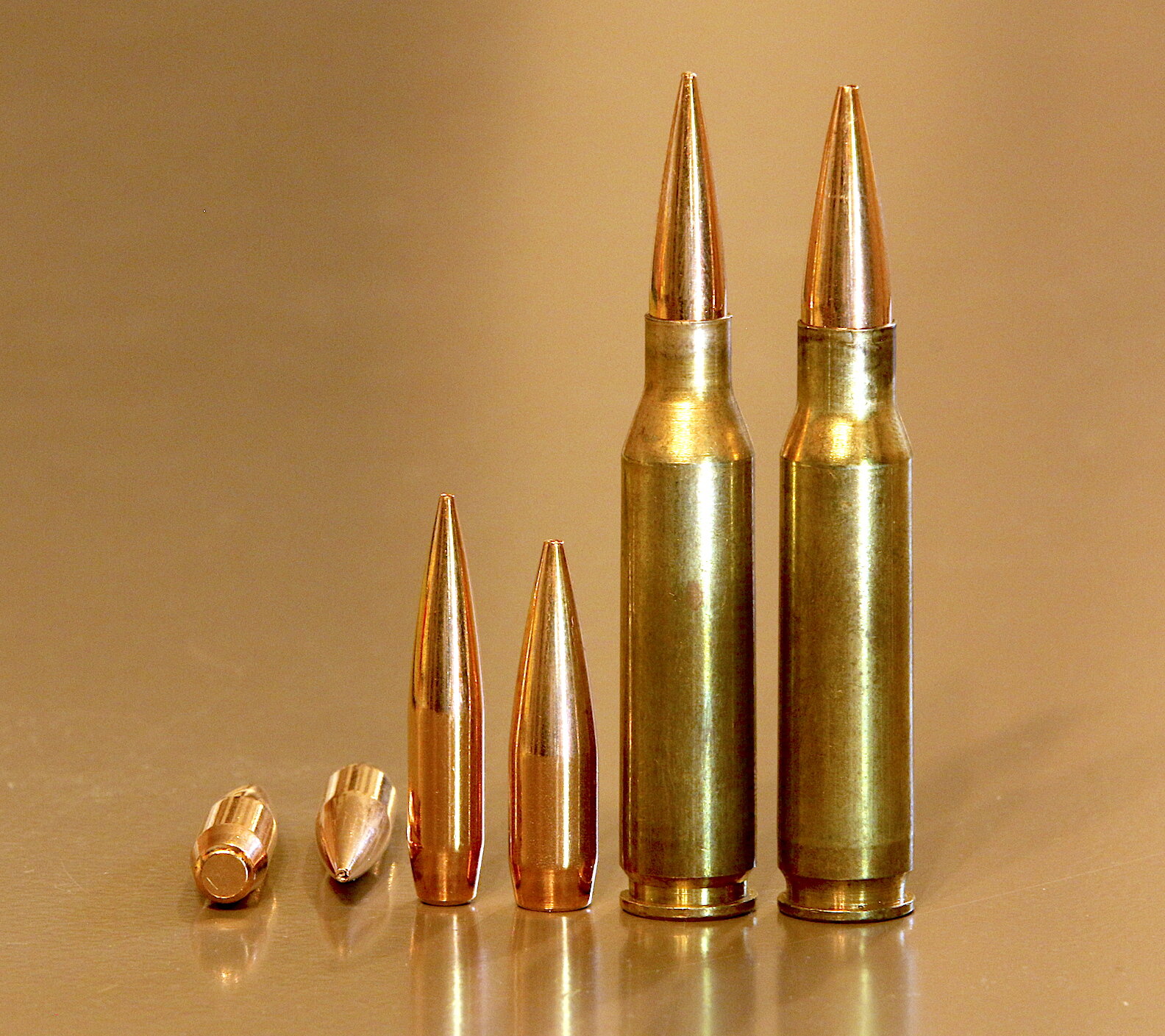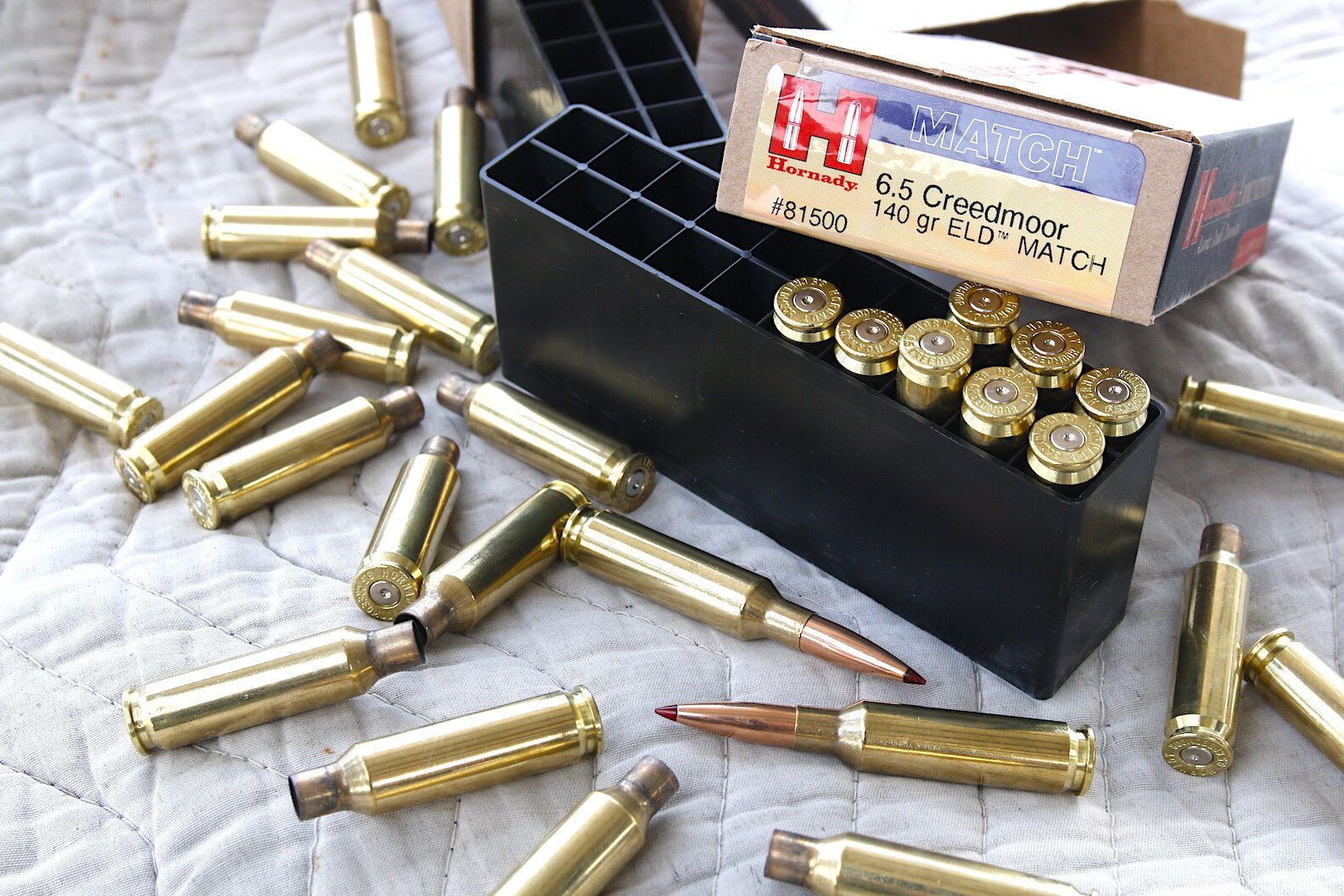Sad 6.5mm Cartridge History
The sad 6.5mm cartridge history in the USA kept the 26-calibers in the cellar until Hornady finally broke through with the 6.5 Creedmoor.
Image show 6.5mm cartridges, the 6.5 Creedmoor, the .264 the really made the 6.5s popular.
Hornady's 6.5 Creedmoor finally put the 26-caliber on US shooters' want lis
t.
World Beating 6.5mm Cartridge
While 6.5s were popular around the world from 1891 on, they were mostly ignored in the U.S. The excellent and still popular 6.5x55 Swede won some converts here, but the only U.S.-made 26-caliber was the short-lived 256 Newton, essentially the 30-06 case necked down. Western Cartridge Company loaded it for a few years starting in 1913.
The next 264 didn't rear it's sorry head until 1958. The 264 Winchester Magnum seemed destined for fame until the barrel burning idea went viral. Then the very similar but slightly wider 7mm Remington Magnum popped out in 1962 and the 6.5mm again shuffled off stage. Our sad 6.5mm cartridge history continued.
Photo shows 264 Winchester Magnum cartridges and ammo box, a 6.5mm cartridge that fizzled.
Despite a promising start, the
was a 6.5mm cartridge that fizzled due to perceived barrel burning issues, but more significantly stiff competition from the more versatile 7mm Rem. Mag.
Everybody to the Shallow End of the Pool!
Remington dipped its toes into the 26-caliber pool with the 6.5 Remington Magnum in 1966. Based on a shortened 375 H&H case, this was an early "short-fat magnum." Too early. Hunters avoided it in droves partly or perhaps mainly because it was first offered in the 18.5-inch barrel Model 600 carbines where it could blow out your ear drums without beginning to reach its velocity potential. By the time it was offered in M700 rifles with 24” barrels, it was too late.
6.5 Rem. Mag. is pictures beside many other 6.5mm cartridges.
Never seen a 6.5mm Rem. Mag? Third from the left. Same case as the belted 264 Win. Mag. just left of it, but shortened to fit short-actions. Why didn't it take off? (Far left is 6.5-284 Norma. Far right 6.5 Creeedmoor with 260 Rem. just left of it. Check out some of those long, sleek bullets!)
Newton's 256 Lives as Wildcat 6.5mm Cartridge
The only truly American 6.5 that gained converts during the last half of the 20th century was never commercialized as such. It was the superb wildcat 6.5-06, the 30-06 case necked down. Yes, same as the 256 Newton with a different title and no one building ammo for it. Handloaders loved it. Behind it in popularity was the 6.5-284 Winchester wildcat with similar ballistic performance. Long-range target shooters started necking down the little-known, short-fat 284 Winchester case (a 1963 release) to 6.5mm in order to enjoy the benefits of long, high B.C. .264” bullets in a shorter action. They were discovering that this bore/bullet size provided a fine balance of ballistic performance and accuracy without undue recoil. Benchrest shooters established 1,000-yard record groups at right around 1.5-inches with the 6.5-284 wildcat. The round proved ideal for deer hunting, too.
Charles Newton's 256 Newton lived on as the 6.5-06 Wildcat and is now wildcatted even farther as the 6.5/280 Ackley Improved shown here. It's just the 30-06 case blow out, shoulder pushed forward and sharpened to 40-degrees, and necked down to .264".
Winchester Misses the Boat
Oddly, Winchester did not capitalize on the rising interest in the 6.5-284 by legitimizing it as the 6.5-284 Winchester. Neither did any other American company. But Norma in Sweden did. That’s why we now have the 6.5-284 Norma. It just squeaked into the pantheon of 20th century commercial rifle cartridges in 1999. It was preceded, however, by one more US 26-caliber that seems destined for the dust heap of cartridges — the 260 Remington.
Image shows 6.5 cartridges known as 6.5-284 Norma.
The Swedes knew a good cartridge when they saw one, so they stole Winchester's thunder and named the 6.5-284 Winchester wildcat the Norma. Norma and Nosler build some great loads for it.
Just as the 30-06 case was necked down to make the 6.5-06, the 308 Winchester case was necked down to form the 260 Remington, which should have been called the 6.5-08 because the A-Square company had filed for that a few months before Remington filed for the 260 Remington designation. One suspects power politics was in play because SAAMI went with the second application. Oh well, regardless who should get name recognition, the 6.5-08/260 Remington remains a great short-action 26-caliber. It actually holds about a grain more powder than the 6.5 Creedmoor case with 140-grain bullets seated, so can usually generate 50- to perhaps 100 fps more MV.
6.5 Creedmoor, 260 Rem., 6.5 Swede, 6.5-284 Norma are 6.5mm cartridges shown
The 260 Remington, 2nd from left, clearly has a bit more powder capacity than the Creedmoor to its left. So does the 6.5x55 Swede to its right and certainly the 6.5-284 Norma far right. All are great deer cartridges and no deer can tell which is which.
Most hunters probably can't either.
Hornady Out Markets Remington
Unfortunately, Remington's marketing can't hold a candle to Hornady's. The only real design advantage the Creedmoor has over the 260 Rem. is that it's been optimized to seat high B.C., long ogive bullets far enough forward to just about kiss the lands to maximize target accuracy potential while still fitting in the shortest short-action magazines. Hornady engineers made it that way on purpose, then followed up with great target bullets loaded in high quality ammo. The subsequent rise in extreme range, PRS-style shooting spotlighted the Creedmoor and everyone jumped on the bandwagon, building dozens of accurate rifles with fast twist barrels to house the new darling 6.5mm.
6.5mm cartridges for short action rifles are 260 Rem. and 6.5 Creedmoor shownside by side for comparison. The Creedmoor shows the long ogive bullets it was designed to best handle.
The 260 Rem. and
are both short actions, but the Creed was engineered to better seat long ogive bullets to just kiss the lands while still fitting inside short magazine wells.
Doesn't Matter For Hunting
None of this makes a gnat's ass of difference in a hunting rifle. Address your average whitetail or mule deer with a 6.5 Creedmoor, 260 Remington, 6.5-284 Norma, or even 6.5 Rem. Mag. (if you can find one) and ask it if knew what hit it.
Photo shows hunter with big whitetail buck taken with 6.5-284 Norma.
This nicely adorned Kansas whitetail didn't know that it had been felled by a 6.5-284 Norma instead of a 6.5 Creedmoor. I hardly remembered myself until I saw that Blaser 93 rifle with the
. It's the only one I've had chambered 6.5-284 Norma.
6.5mm Cartridge Magic
Most of the magic in any 6.5mm cartridge is the long, high B.C. bullet supported by fast rifling twist barrels. And in weights that don't generate so much recoil we can fire them without flinching. The typical 130- to 147-grain .264 bullet at 2,700 to 3,000 fps happens to be just right for terminating most common big game, too. Realistically our mid-power .277s, .284s, and .308s do the same, but those are old hat. These days, more than a century behind the rest of the world, U.S. shooters and hunters are in love with the 6.5mm cartridge. Lots of them.
6.5mm cartridges lined up are just some of the 264s popular today.
Hot stuff. 6.5mm cartridges are all the rage now. L. to R. are 6.5 Creedmoor, 260 Rem., 6.5x55 Swede, 6.5-284 Norma, 6.5 Rem. Mag., and 264 Win. Mag.
The author enjoys working with 26-caliber cartridges as much as anyone, but he's not walking away from his 25, 27, 28, and 30 calibers.





















